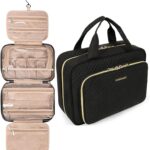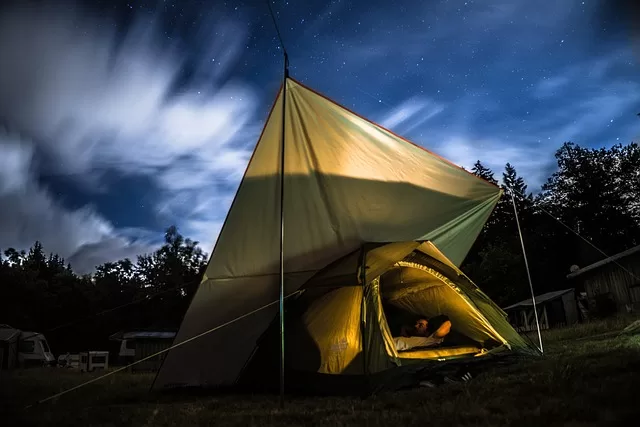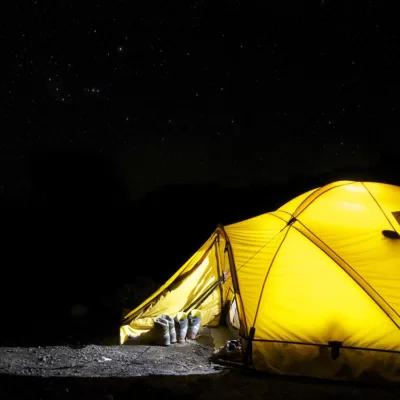Nothing compares to getting away to the great outdoors for a camping trip as the world grows busier and everywhere has been made a bubbling city. You should see some of the most stunning and mind-blowing natural beauties our world has to offer, and what better way to do it? Start by planning a successful and enjoyable camping trip. Camping in national parks is an unforgettable experience and a haven for nature lovers.
The United States is blessed with a wealth of undiscovered natural beauty, from the gushing geysers of Yellowstone to the glaciers and lovely lakes of Glaciers Park. This article will examine five national parks that you absolutely must visit on your upcoming camping trip, each of which has distinctive features and activities to offer. Visiting these national parks for your next camping trip will leave you with lifelong memories whether you’re a seasoned camper or a novice to the great outdoors.
Great Smoky Mountains National Park
The Great Smoky Mountains National Park, which covers 522,427 acres in Tennessee and North Carolina, is a national park in the Southern Appalachian Mountains of the United States. With more than 12 million visitors per year, it is the most popular national park in the United States since its establishment in 1934.
The park is called for the blue mist that frequently envelops the mountains and is brought on by the area’s abundant vegetation and trees naturally releasing volatile organic chemicals. A rich history of human habitation extending back over 9,000 years may be found in the park.
Unique Features
With over 19,000 recognized species of plants, animals, and fungi, the Great Smoky Mountains National Park has tremendous biodiversity, which is one of its most distinctive characteristics. One of the world’s most diversified temperate woods, the park is also home to over 100 different tree species.
A second reason the park is well-known and would be one of the perfect national parks for your next camping trip is for the more than 100 distinct waterfalls that can be found there. Grotto Falls, Laurel Falls, and Abrams Falls are a few of the most well-known waterfalls.
Best Camping Spots
Visitors to the Great Smoky Mountains National Park have a selection of camping alternatives. The park offers backcountry camping alternatives in addition to eleven constructed campgrounds with a total of approximately 800 campsites. The following are some of the park’s top camping spots:
- Elkmont Campground: This campground, which is close to the Little River, is open from early March until late November and has around 200 campsites.
- Cades Cove Campground: This campground, which has approximately 160 sites and is close to the Cades Cove Loop Road, is available from early March to late November.
- Cosby Campground: Located near Cosby Creek, this campground offers over 150 sites and is open from early April through late October.
Activities to Do While Camping
In the Great Smoky Mountains National Park, there are lots of things to do while camping with friends. The most well-liked activities include:
- Hiking: The park offers over 800 miles of trails, ranging from easy strolls to strenuous hikes. Some of the most popular trails include the Appalachian Trail, Chimney Tops Trail, and Alum Cave Trail. Take along with you your hiking boots for an adventure exploring the scenic park.
- Fishing: The park is home to over 2,000 miles of streams, making it an excellent destination for fishing enthusiasts. The most popular fish to catch include rainbow trout, brown trout, and brook trout. Don’t forget to pack your camping fishing gear and tackle and get set to have the most fun time of your life.
- Wildlife viewing: The park is home to a variety of wildlife, including black bears, deer, elk, and over 200 species of birds. Visitors can take a guided tour or explore on their own to see these animals in their natural habitat.
- Scenic drives: The park offers a variety of scenic drives, including the Cades Cove Loop Road, Newfound Gap Road, and Roaring Fork Motor Nature Trail. These drives offer stunning views of the mountains and surrounding landscape.
When to Visit
The Great Smoky Mountains National Park is open year-round, but the best time to visit depends on what you want to do. Here are some tips:
- Spring: Spring is a popular time to visit the park, as the wildflowers are in bloom and the weather is mild. However, the park can be crowded during this time.
- Summer: Summer is the busiest time of year in the park, as visitors flock to the mountains to escape the heat. Be prepared for crowds and high temperatures if you visit during this time.
- Fall: Fall is perhaps the most popular time to visit the park, as the leaves change color and the weather is cool and crisp. The park is top on the list of campsites for fall foliage. However, the park can be crowded during peak leaf season.
- Winter: Winter is a quiet time in the park, with fewer visitors and often snow on the ground. Some of the park’s roads and facilities may be closed during this time. The park is also one of the best campsites for winter camping just in case you may consider looking up some tips for winter camping to try out a winter camping adventure.
Visitor Information
The Great Smoky Mountains National Park is open year-round, and there is no admission fee. However, some activities, such as camping and backcountry hiking, require permits or fees.
Visitors to the park should be aware of the potential hazards of the area, including weather conditions, wildlife, and rough terrain. It is important to be prepared and to follow safety guidelines when exploring the park.
Grand Canyon National Park
The Grand Canyon National Park spans over 1.2 million acres and is situated in Arizona, USA. It was made a national park in 1919 and has since grown to be one of the most popular locations for outdoor enthusiasts worldwide. The Colorado River carved the Grand Canyon over millions of years, and it is almost 277 miles long and may go as wide as 18 miles.
Camping Options and Facilities
The Grand Canyon National Park is one of the best national parks for your next camping trip. The camping options for visitors range from developed campgrounds with amenities to backcountry camping.
There are four developed campgrounds located on the South Rim of the canyon, which are open year-round and can accommodate car camping, RVs, and tents.
These campgrounds have amenities such as restrooms, showers, and laundry facilities, as well as campfire rings and picnic tables.
Backcountry camping is also available but requires a permit and is subject to specific regulations. Visitors should be aware that camping in the backcountry can be challenging due to the rugged terrain and extreme weather conditions.
Must-See Attractions
Here are some must-see attractions for when you go camping at the Grand Canyon National Park.
South Rim
The Grand Canyon’s South Rim is the most visited part of the park and provides breathtaking views of the canyon. Visitors can explore the numerous trails and views spread out around the area, take a picturesque drive down Hermit Road or Desert View Drive, or both. The Grand Canyon Village, which has a variety of services like restaurants, souvenir stores, and tourist centers, is situated on the South Rim of the canyon.
Grand Canyon Village
On the South Rim, the Grand Canyon Village serves as the main center of activity and is home to a number of tourist attractions. The El Tovar Hotel and the Bright Angel Lodge are two examples of the early 20th-century buildings and structures that may be found in the ancient village. A guided tour of the village is also available, but visitors may also wander about on their own and explore the numerous stores, eateries, and art galleries scattered around the neighborhood.
Bright Angel Trail
One of the most well-known paths in the park, the Bright Angel Trail, provides breathtaking canyon views. The trail starts at the South Rim and descends more than 4,000 feet to the Colorado River, making stops along the way at Plateau Point and Indian Garden. The length and steep inclines of the trail can make it difficult, so visitors should be aware of this and come prepared with the right supplies and equipment.
Colorado River
The Grand Canyon’s lifeblood, the Colorado River, provides visitors with a variety of thrilling things to do while camping, from rafting and kayaking to swimming and fishing. Guests have the option of taking a guided tour of the river or going on their own exploration to find the numerous undiscovered coves and beaches that line the shore.
Activities to Do While Camping
Here are the most fun things to do while camping at any of the campgrounds at Grand Canyon
- Hiking: The Grand Canyon National Park is home to over 300 miles of hiking trails, ranging from easy, paved paths to challenging backcountry treks. Hikers can explore the many different ecosystems and geological formations that make the Grand Canyon such a unique and fascinating destination.
- Wildlife Viewing: The Grand Canyon is home to a diverse array of wildlife, including elk, deer, bighorn sheep, and coyotes. Visitors can spot these animals from the many overlook.
- Take a scenic drive.
- Simply relax and enjoy the stunning views.
- The park also offers a range of educational and interpretive programs, as well as special events throughout the year.
Zion National Park
For campers and outdoor enthusiasts, Zion National Park in southwest Utah, USA, is one of the must-visit national parks for your next camping trip. The park is well-known for its breathtaking red rock formations, variety of fauna, and an assortment of outdoor pursuits.
Almost 232 square miles of land are protected within Zion National Park, which was created as a national park in 1919. The park is 160 miles northeast of Las Vegas, Nevada, and is situated in southwest Utah. The history of the region goes back over 8,000 years, and there is proof that people have lived there and used the land for gathering and hunting. Once European settlers started to explore the region in the 19th century, Zion Canyon rose to prominence as a tourist and outdoor leisure hotspot.
Unique Features
Zion National Park’s breathtaking red rock formations, which were created over millions of years by erosion and sedimentation, are one of its most distinctive features. Bighorn sheep, mule deer, and many bird species are among the fauna that calls the park home. Angel’s Landing and The Narrows are two other distinctive hiking trails in Zion National Park that provide hikers with hard yet rewarding experiences.
Best Camping Spots
Visitors to Zion National Park have a variety of camping alternatives, including back-country camping and constructed campgrounds with facilities. Watchman Campground, South Campground, and Lava Point Campground are the three developed campgrounds that are situated inside the park. Restrooms, showers, and laundry facilities are among the amenities that each campground provides. With a permit, there are also lots of wilderness camping opportunities, including locations near the Zion Narrows, Subway, and West Rim Trail.
Activities to Do While Camping
In addition to camping, there are many activities to do in Zion National Park. Visitors can explore the park’s numerous hiking trails, ranging from easy nature walks to challenging hikes such as Angel’s Landing and The Narrows. The park also offers a range of ranger-led programs, including guided hikes and evening programs. Other activities include rock climbing, canyoneering, and scenic drives along Zion Canyon Scenic Drive and Kolob Canyons Road. You may as well pack up your own camping games to enjoy.
Must-See Attractions
Zion Canyon
Zion Canyon is the most popular area of the park and offers stunning views of the red rock formations. Visitors can take a scenic drive along Zion Canyon Scenic Drive, or explore the many trails and overlooks located throughout the area. The Zion Canyon Visitor Center is also located in this area and offers a range of educational exhibits and ranger-led programs.
Angel’s Landing
Angel’s Landing is a popular hiking trail in the park that offers stunning views of the canyon from the top. The trail is approximately 5 miles round trip and has steep inclines and drop-offs, making it a challenging but rewarding hike. Visitors should be aware that the trail can be crowded and is not recommended for those with a fear of heights.
The Narrows
The Narrows is a unique hiking trail in the park that takes visitors through the narrowest section of Zion Canyon. The trail follows the Virgin River and requires hikers to wade through water at certain points. Visitors should be aware that the trail can be challenging due to the cold water and uneven terrain and should be properly prepared with appropriate gear and supplies.
Emerald Pools
The Emerald Pools are a series of pools and waterfalls located in the park that offer a refreshing break from the desert heat. Visitors can hike to the lower, middle, and upper pools, each offering unique views and scenery.
Glacier National Park
Camping lovers should definitely visit Glacier National Park, which offers spectacular vistas of untamed mountains, clear lakes, and towering glaciers. This national park, which spans more than 1,000,000 acres in Montana’s Rocky Mountains, is home to over 130 named lakes, 25 glaciers, and numerous other wildlife species.
It is definitely one of t must-see national parks for your next camping trip in the country. The park, which bears the name of the numerous glaciers that were created over thousands of years by ice and snow, was founded in 1910. Rugged mountains, thick woods, and pure lakes make up the park’s terrain, which makes it a haven for adventure enthusiasts. A variety of unusual animal species, such as grizzly bears, mountain goats, and bighorn sheep, call the park home. You should actually have some tips for dealing with wildlife up your sleeves.
Camping Options and Facilities
Glacier National Park offers a variety of camping options, from primitive sites to RV parks with full hookups. There are 13 campgrounds in the park, with a total of 1,009 sites available. The campgrounds are open from May to September, with some campgrounds open year-round. Reservations are highly recommended, as campsites fill up quickly, especially during peak season.
All campgrounds in the park offer picnic tables, fire rings, and access to water and restrooms. Some campgrounds also offer showers and laundry facilities. Some of the most popular campgrounds in Glacier National Park include:
- Many Glacier Campground: This campground offers breathtaking views of the surrounding mountains and is situated on the east side of the park, close to the Many Glacier region. It is open from mid-June through mid-September and has 109 locations.
- Apgar Campground: This campground provides quick access to Lake McDonald and is situated on the park’s western edge, close to Apgar Town. It is accessible year-round and contains 194 locations.
- Two Medicine Campground: This campground offers stunning views of the surrounding mountains and lakes and is situated on the east side of the park, close to the Two Medicine region. It is open from mid-June through mid-September and has 99 locations.
Must-See Attractions
- Going-to-the-Sun Road: One of the most beautiful drives in the nation, this 50-mile route offers breathtaking vistas of the glaciers and lakes in the park. Visitors can drive the road alone or enjoy a guided trip from late June to mid-October.
- Grinnell Glacier: This glacier is the most famous and largest in the park, and can be accessed by hiking the Grinnell Glacier Trail. The trail is a strenuous 11-mile round trip but offers incredible views of the glacier and surrounding mountains.
- Lake McDonald: This is the largest lake in the park and offers a variety of recreational activities, including fishing, boating, and swimming. Visitors can also take a scenic boat tour of the lake.
- Many Glacier: This area of the park is known for its stunning mountain scenery and wildlife viewing opportunities. Visitors can take a guided horseback ride or hike to some of the area’s most popular destinations, such as Grinnell Lake and Iceberg Lake.
Popular Activities for Campers
Glacier National Park offers a wide range of things to do while camping with family or friends here, including hiking, wildlife watching, fishing, and scenic drives. The park has over 700 miles of hiking trails, ranging from easy nature walks to challenging hikes like the Grinnell Glacier Trail. Wildlife viewing is also a popular activity in
Yellowstone National Park
One of the first national parks established in the United States is Yellowstone National Park, which is largely in Wyoming. When considering some of the top national parks for your next camping trip, you should actually include Yellowstone as a must-see. It was founded in 1872 and is renowned for its extensive wilderness, geothermal characteristics, and diverse animals.
More than 2.2 million acres of the park are spread throughout Wyoming, Montana, and Idaho. The greatest geothermal area in the world, including the Old Faithful geyser, is located in Yellowstone. The history of the park is extensive and varied, ranging from its Native American inhabitants to its contribution to the creation of the National Park System.
Camping Options and Facilities
Almost 2,000 campsites are available in 12 campgrounds at Yellowstone National Park for guests. The National Park Service manages the campgrounds, which provide campers with a range of alternatives, from traditional camping to RV hookups.
It is strongly advised to make reservations, especially during the busiest summer months when the campgrounds quickly fill up. For individuals who desire to explore the park’s wilderness sections, Yellowstone offers backcountry camping choices in addition to conventional camping.
Must-See Attractions
- Old Faithful: This iconic geyser erupts regularly, sending plumes of hot water and steam up to 180 feet in the air.
- Grand Prismatic Spring: This is the largest hot spring in the United States, known for its vibrant colors and rainbow-like appearance.
- Lamar Valley: This expansive valley is a prime location for wildlife viewing, especially for bison, elk, and wolves.
- Yellowstone Lake: The park’s largest body of water offers opportunities for boating, fishing, and scenic hikes.
Activities to Do While Camping
- Hiking: Yellowstone has over 900 miles of hiking trails, ranging from short, easy walks to multi-day backpacking trips.
- Wildlife Watching: Yellowstone is home to a diverse range of wildlife, including grizzly bears, wolves, elk, and bison. Visitors can participate in guided tours or explore on their own.
- Fishing: Yellowstone’s rivers and lakes offer some of the best trout fishing in the world. A fishing license is required and can be purchased at various locations within the park.
- Ranger Programs: The park offers a variety of ranger-led programs, including campfire talks like a guide for campfire safety, as well as talks on building a perfect campfire and protecting the environment while camping. They also offer guided hikes and educational programs for children.
Conclusion
For your upcoming camping trip, these 5 national parks are a must-see since they provide a plethora of scenic beauty, interesting attractions, and fun outdoor activities. These places have something to offer every kind of camper, from the soaring peaks of Glacier National Park to the breathtaking canyons of Zion National Park.
Geysers, hot springs, and vibrant pools are just a few of the remarkable natural treasures found in Yellowstone National Park. While the towering rock formations and famous views of the Colorado River at Grand Canyon National Park are truly spectacular.
Nature lovers can find peace in the Great Smoky Mountains National Park’s lush forests and rolling slopes, while hikers and animal enthusiasts will find heaven in Glacier National Park’s breathtaking glaciers and pristine lakes.
Last but not least, Zion National Park’s slender canyons and soaring cliffs provide a rare chance to experience some of North America’s most remarkable natural settings.
These national parks provide an opportunity to escape the pressures of contemporary life and reconnect with nature, regardless of whether you are an experienced camper or are just getting started. Pack your camping gear and equipment, get on the road, ready for a once-in-a-lifetime experience in one of these national parks for your next camping trip.


























